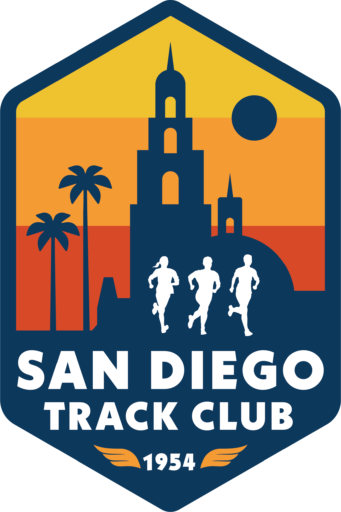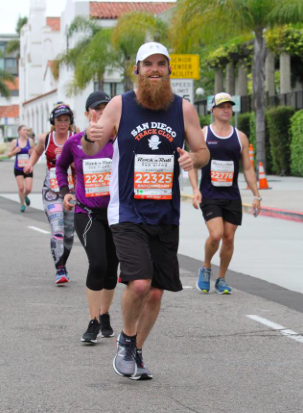Lessons from a first-time marathoner
When I set out to run a marathon, my motivation was to prove something. To myself, to everyone around me. Through a lot of personal growth over the past five months, I’ve stopped feeling the need to prove something. However, I knew that I still wanted to run, I just didn’t know why. Knowing your why is an important element of training for a full marathon and getting through the race.
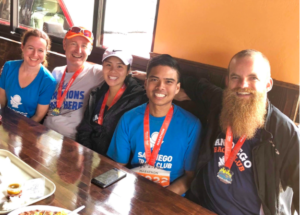
A week before the marathon, I was journaling about “why” I’m doing this crazy thing. I use a variation of a technique known as the “5 Why’s” to really understand my true motivations. It inspired me to write a short poem that I can re-read (like 10 times the night before the race) to get inspired. This is what helped me to truly enjoy the marathon despite so much going wrong.
“Why I run”
The rush of energy,
Nerves firing, emotions flowing.
The world stands still,
As I glide through time.
Pain as a reminder,
to listen and be mindful.
Cleansing the soul,
Of the day’s toxins.
Camaraderie with strangers,
Forming a supportive community.
Tiny little moments,
Of pure, raw joy.
Balance in mind, body, spirit,
I run to thrive.
Race Day
All week I had been getting the final preparations together. Nutrition, sleep, checklists, more checklists. I was over-prepared for this thing. Here is how the day went…
- My alarm was set to 4:45 AM. When I woke up, there was too much light in the sky. I knew something was wrong. Looked at the clock, I missed my alarm! It was 6:15 AM, the time the race starts. My phone was blowing up with messages from friends wondering where I was. Especially my good friend Taylor in town from Los Angeles who was on this journey with me and waiting for me to pick him up. Luckily he got a ride! BIG HURDLE #1
- I knew that the rear end of the race corrals wouldn’t likely start until after 6:30 and I may still have a chance at making it. I had to make the difficult decision to cross off two very important parts of my morning routine because I didn’t have the time – my breakfast (meal replacement shake) and my trip to the bathroom. BIG HURDLE #2
- I called an Uber driver who luckily was more than willing to speed and run stop signs to get my ass to the starting line. I got there just around 6:40 despite traffic and road closures, checked my bag, and jumped in the corral. Luckily I found SDTC and #TeamDowntownish friend Jason among what seemed like a million sardines packed together!
- Despite the morning hiccup, I made it and was feeling very positive. I knew “why” I was there, I knew I was prepared, and my mental state was very positive, ready to have fun, and hit my goal.
- The race started! I was off to a good pace and seeing a lot of friendly faces cheering me on along the race including my SDTC mentor Dan Heller who once gave me wise advice not to try and run with the cute girls at the Tuesday track workouts because they were too fast and I would end up hurting myself (I didn’t listen, I chased Victoria and hurt my hips. #chasingvictoria). I remember thinking to myself “wow I’m still super stoked despite all that has gone wrong… I got this!”
- Mile 6, my nipple covers fell off. Throughout the race, I went through three sets of nipple covers, duct tape, then finally resorted to vaseline. I checked-in with my mindset and reminded myself to practice everything I learned from Stoicism. Focus on what I can control, like getting those damn nipples covered up, and not letting my emotions be controlled by things I couldn’t control. BIG HURDLE #3
- Half way: I was moving fast, feeling strong, but my stomach turned into a complete mess by that point. I realized I was going to have to use a porta potty at some point. I was on pace to hit my stretch goal (sub 4 hours) and so I went full mind over matter and tried to tough it out. Around mile 20, I caved and attempted to stop, knowing I couldn’t go on any longer. Unsuccessful attempt!!! Excruciating stomach pains, no relief. HUGE HURDLE #4
- The failed porta potty stop led to me getting seriously discouraged for a moment and in so much pain I didn’t know what to do. I’ve had serious stomach issues in my life, especially from international travel. This was much worse. My pace started slowing just before the hardest part, the insane 163 HILL FROM HELL. I also started having a ton more pain in my feet than normal for me. Those feet were just going to have to suffer. I was finishing no matter what.
- Bottom of the hill: I was still on track to hit my stretch goal. I hit my first goal of getting to the bottom of the hill with enough time left to give myself a shot at hitting the stretch. I had accepted the stomach pain for what it was and knew I would have to finish with it. I got my mind right and hit the hill. By the top of the hill, I instantly realized the hip injury that took me out of training for a month earlier this year had just been re-injured. RACE KILLER HURDLE #5
- I knew I would need to check-in with myself at the top of the hill and determine how to approach the final 5k. The hip injury made it very clear, I would be lucky to even jog slowly for the final 5k. My good friend and #TeamDowntownish teammate Michelle, who I had passed earlier, ran by me and said “Don’t you fucking give up Hansen.” She is the best. I didn’t give up. I shed a quick tear knowing my stretch goal was gone but I was not out of this thing yet.
- I need my music on long runs to really get me moving faster. At the top of that hill, at the hardest moment for me when I really needed something to push me, my bluetooth headphones died. I never got to hear my final motivation songs from the playlist. TOUGH MENTAL HURDLE #6
- Although I couldn’t move my knee in front of my body or lift it to speed up the pace, I was able to jog through the injury. I finished the marathon in 4:08, barely able to lift my arms up in victory.
- Despite all my training, I was wrecked. Mentally, physically, emotionally. My family saved my ass after the finish. I couldn’t walk, stand, see straight, think straight. I broke down at one point. So much pain, so many emotions, such a long walk to the bathroom. I mustered up a quick smile for the photo opp but don’t let that fool you. I was destroyed.
- I finally made it to the San Diego Track Club tent, used the restroom several times, and started the road to recovery. The hugs from my teammates when I made it to the tent nearly had me in tears. We had gone through so much together to get here. Many of us first timers, learning together, pushing each other, and picking each other up when we were down. It was time for the ritual post-long run burritos with #TeamDowntownish. That burrito was life-changing and it was a nice moment of joy sharing war stories with the gang.
- Barely able to move and keep myself from fainting, I hit the couch and threw on ice packs. I stayed there for several hours. My right hip was useless, making every movement a big ordeal. Road to recovery looked long.
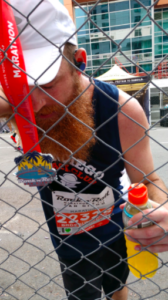
7 Race Preparation Lessons
- Balance running with strength training. If I would have done that, my hips would have had a chance at surviving that hill.
- Build your tribe. You are going to need people to get through the training and race. Shout out to #TeamDowntownish, San Diego Track Club, my mentor Dan, Taylor, Peter, and my family.
- Know “why” you run. That kept me going through all my hurdles.
- Set 3 alarms and turn the phone ringer volume up.
- Don’t ever sacrifice your breakfast and pre-race poop no matter how late you are.
- Test that your electronics can last longer than the time of your race goal.
- Have fun. I did that, and it’s the one big highlight of the day for me. Despite six huge hurdles and not having my running buddies next to me (because I was too late), I still had a lot of fun. High-fiving friends and people cheering, pumping up runners around me, dancing to my favorite jams (pre-headphone death), and just taking it all in including this beautiful city we live in. I was able to smile nearly the entire race and afterward as I shared my story with friends and family. I wouldn’t trade that for the world.
The Emotional Rollercoaster
Talk about a rollercoaster of emotions. I still can’t explain them or even identify them all. Just six months ago, I didn’t even know how to process or acknowledge emotions, so this was like the fireworks grand finale on 4th of July.
Love, pride, gratitude, joy, achievement, sadness, pain, failure, loneliness, fear, anxiety, loss… all swirling about inside me and each one rearing its head at unexpected times. I’m still learning to love my emotions so this has been quite the wild ride for me. 26.2 miles and 22 weeks of grueling training works things out you never knew were there.
The work I put in on my mental and emotional health over the 22 weeks of training were vital to getting me through this journey. Don’t wait until the week of the race to learn how to sit with and understand your emotions. This takes just as much practice (I work on this at least six days per week each morning) and not only will it help you enjoy the race but it will also have a major impact on your personal life and relationships.
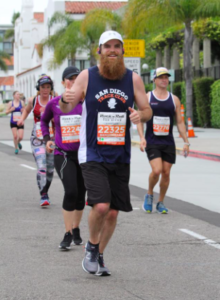
11 Life Lessons
- Overcoming obstacles: No matter what, there will be obstacles in your way, especially when you are trying to achieve great things. How you mentally approach the obstacles will determine if you can thrive through them. There is no way around them, and as Ryan Holiday teaches, The Obstacle is The Way.
- Preparation: Preparing for the known and unknown. When you are aiming for something big, and preparing for months on end, many things will go wrong before, during, and after the event. You can’t expect to be successful by only preparing for the known, you must prepare for the unknown.
- Community: Don’t underestimate the value of community. My entire life I tried to tackle everything alone and wound up depressed even if I achieved success. Choose your tribe wisely, show up for them, and they will show up for you. “If you want to go quickly, go alone. If you want to go far, go together.” (source unknown)
- Pivoting: Know when it is time to change directions. Your goal, your strategy, tactics. I pivoted four times throughout marathon training. First, I had to change my running form which had been ingrained in me since high school. Next I had to change my marathon goal time. Third was figuring out the new reason (my “why”) for running. Lastly, my pace and nutrition strategy which I worked so hard on. I threw it out the door the night before the race. Continuously practice checking in with yourself, team, and mentors then be honest with what you should change.
- Commitment and determination: There will be many grueling days that test your commitment. You have to stay focused and put in the work even when it feels like you’ll never make it. As Scott Belsky teaches in The Messy Middle, DYFJ, or “do your f’ing job.” Keep an eye on where you are headed but show up and do the hard work day-in and day-out.
- Know your why: If you want to accomplish something great and be able to overcome obstacles, you better know why you want it so badly. Theodore Roosevelt once said “Nothing in the world is worth having or worth doing unless it means effort, pain, difficulty.” Knowing your “why” is what will get you to the finish line.
- Laugh: When shit goes wrong, laugh. You knew it was coming, acknowledge it, laugh at it, move forward. When things go right, smile and laugh with your friends who supported you on the journey. Either way, keep having fun. If it’s not fun anymore, go back to the previous lesson.
- Always be listening: To your body, your emotions, your coaches/mentors, your doctor. Even to naysayers, detractors, bad bosses, negative people, and anyone you feel is getting in your way to success. When you are listening, you are learning and improving.
- Visualize: Every successful endeavor has started with someone visualizing the success early on. That image in your head may change as you pivot, but don’t forget to set aside time for visualizing what the final result will look like and each important step along the way. In the marathon, I visualized conquering the hill and my running form, the water stations, my cruising speed, my finish. When the time comes to perform, the visualization becomes a reality.
- Practice: In order to be ready for the unknown, the known must be second nature. That only happens through extensive and repetitive practice. I should have practiced more since my headphones died, nip guards fell off, and stomach killed me. I could have better prepared my nutrition strategy. I could have fully practiced my routine at least once. I needed to practice longer training runs at my goal pace. I was short on time due to an injury, but more practice could have really helped me. On the day of your big event, you don’t want to spend your time and energy on things that should be second nature. You will need that energy for what obstacles lie ahead.
- Ownership: At the end of the day, it’s up to you to own it. Your body, your mind, your spirit. No one is going to do the hard work for you. The community will help along the path, but it’s up to you to get across that finish line. It’s up to you to listen to your body and know when to slow down, speed up, or seek help.
If you’ve been following me on social media, you probably know this race was more to me than just 26.2 miles. It’s a big piece of my operation #TakeBackControl, which I set out on December 18th, 2018, to regain control of my life from addiction, depression, and other outside influences I had let creep in. I DID IT!
This is just phase one of my journey. You can follow along on Instagram, Facebook, or show up to track club and let’s run together.
